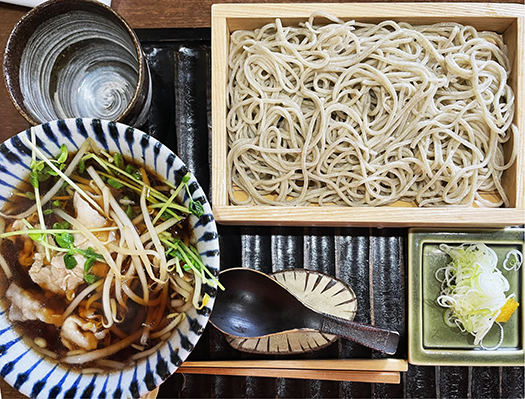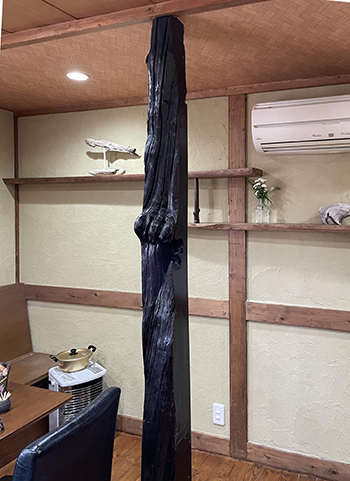


食事の改善に取り組んでいるのですが、それでも自宅でばかりは食事できません。旅に出たりすればどうしても外食の機会が増えることになる。そういう傾向となると対策はそば食になる。
写真は函館からの帰り道、黒松内町で入ったそば店。カミさんのWEB検索で引っかかってきた「穴場」系のお店。黒松内は道の駅がおいしいパンで評判になっていましたが、その100mほど並びに札幌から移住した店主が開店した「そば屋この花」というお店。
お昼時に行ったら待ち時間30分と言われましたが、道の駅で時間をつぶしていれば、ということで待つことにした次第。そうしたら道の駅でばったりと「雪だるまの家」の藤城社長と遭遇。すっかり話し込んでしまっておりました。・・・ということでさほどの苦もなく入店した。
で、「豚しゃぶそば」というメニューに夫婦とも一択。この豚しゃぶ、なかに大量の「もやし」が入っていました。カミさんには「ちょっと・・・」ということでもやしが多すぎたようですが、食事改善中のわたしには、食物繊維豊富なもやしは、炭水化物食とバランスが良いというイメージがあって、大変嬉しく食させていただいた。あ、ゆっくり、20分程度時間を掛けた(笑)。
で、空腹だったではじめはそれほど気付かなかったのですが、面白い店舗の雰囲気に徐々に気が回っていった。人間、現金なもので、腹が満たされて初めて周辺に気が向くようになる。
なんでも移住に当たって中古住宅を購入してそれを改造したお店なのだそうです。たいへん印象的な床柱がすっくと立っている。たぶん塗装も加えたのか、加齢による姿の変形がそのまま独特の味わいを見せている。あやかりたい。お昼時の最終の客だったようでたっぷり濃いめの「そば湯」でしたが、その容器も、まるで自然木のような姿カタチ。

この写真はまったく無関係な関東地域の古民家の内観ですが、わたしが古民家に惹かれるのは、こういうそば食数寄ともなんとなく通底する部分がある。
っていうか、そば食を提供するような人間は、住空間インテリアについても強い感受性を持っているように思われるのです。そば食にとってインテリアは、すでに味の重要な部分になっているのではないでしょうか。きっとそば本来の味わいには、繊細な味への感受性があって、そういう感受性の人物には脳の似通った領域として空間認識もあるのではないでしょうか。
山形の田舎町でお昼時間になって地元の方にご案内いただいた「田舎の農家」などでは、それこそ看板すら掛けていない古民家農家で、その囲炉裏端で食事時間を味わった。味と空間が渾然一体となって客をもてなしていたように思うのですね。住空間創造にとっても、興味深い部分ですね。
English version⬇
Atmosphere is essential to the “umami” of soba.
In the human brain, the region that perceives taste and the region that perceives space are very close to each other, or perhaps they are the same region. Soba and private houses are similar in sensory perception. Soba and minka, the Japanese traditional Japanese house.
I am working on improving my diet, but I still cannot eat only at home. If we travel, we will inevitably have more opportunities to eat out. With such a tendency, the countermeasure is to eat buckwheat.
The photo shows a soba restaurant we entered in Kuromatsunai Town on our way back from Hakodate. It was a “hole-in-the-wall” type restaurant that my wife’s web search turned up. The roadside station in Kuromatsunai was well known for its delicious bread, and about 100 meters away from the station was a restaurant called “Soba Restaurant Konohana,” which was opened by the owner who moved from Sapporo.
When I went there at lunchtime, I was told that the wait would be 30 minutes, but I decided to wait as long as I could kill some time at the roadside station. Then I bumped into Mr. Fujishiro, the president of “Snowman’s House” at the roadside station. We had a nice chat with him. So we entered the restaurant without much trouble.
Both of us chose the “Pork Shabu Soba” as our entrée. This pork shabu-soba had a lot of “bean sprouts” in it. My wife thought it was a little too much, but I was very happy to eat it, because I have an image that sprouts, which are rich in dietary fiber, are well-balanced with carbohydrate meals. I took my time, about 20 minutes (laugh).
And I was hungry, so I didn’t notice much at first, but the interesting atmosphere of the restaurant gradually got my attention. People are cash animals, and it is only when their stomachs are full that they start to pay attention to their surroundings.
The restaurant is a remodeling of a used house that the owner bought when he immigrated to Japan. A very impressive floor pillar stands there. The deformation caused by aging, perhaps with the addition of paint, gives it a unique flavor. I would like to be thanked for this. We were the last customers at lunchtime, so the soba-yu (buckwheat noodle soup) was thick and rich, but the container was also shaped like natural wood.
This photo is an interior view of an old private house in the Kanto region, which is completely unrelated to this project, but my attraction to old private houses has something in common with this kind of soba-mokuzoku.
In fact, it seems to me that the people who serve soba food also have a strong sensitivity to the interior design of their living space. I believe that interior design is already an important part of the taste of soba food. I am sure that the original taste of soba has a sensitivity to delicate flavors, and that such a sensitive person may also have spatial perception as a similar area of the brain.
In a rural town in Yamagata, I was guided to a “country farmhouse” by a local at lunchtime, an old farmhouse without even a signboard, where I savored my meal by the hearth. It seems to me that the taste and the space were a whole new combination in the hospitality of the guests. This is an interesting part of the creation of living space.
Posted on 4月 28th, 2023 by 三木 奎吾
Filed under: おとこの料理&食, 住宅性能・設備







コメントを投稿
「※誹謗中傷や、悪意のある書き込み、営利目的などのコメントを防ぐために、投稿された全てのコメントは一時的に保留されますのでご了承ください。」
You must be logged in to post a comment.